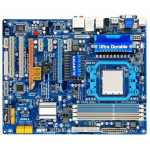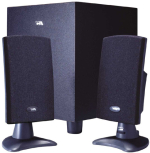System Buyers' Guide: PCs for Under $1000
by Sean Hollister on February 12, 2010 2:00 AM EST- Posted in
- Guides
AMD Mainstream PC
To be completely honest, the AMD Phenom II X3 720 Black Edition is not quite the equal of Intel's Core i3-530. In our tests, it came in slightly behind in practically every single benchmark, regardless of how many threads the applications used. But it comes very close, and if you buy into the value-packed AM3 platform using the X3 720 as your entry point, you'll have plenty of other features to go along with it.
| AMD Mainstream System | ||
| Hardware | Component | Price |
| Processor | AMD Phenom II X3 720 BE Heka (Tri-core 2.8GHz, 45nm, 3x512KB L2, 6MB L3) |
$125 |
| Cooling | CPU Retail HSF | $0 |
| Video | PowerColor Radeon HD 4850 512MB | $100 |
| Motherboard | Gigabyte GA-MA790XT-UD4P AM3 (before $15 Rebate) | $105 |
| Memory | G.Skill Ripjaws 4GB DDR3-1600 F3-12800CL9D-4GBRL | $105 |
| Hard Drive | WD Caviar Blue 500GB WD5000AAKS | $54 |
| Optical Drive | Sony Optiarc Model AD-7240S-OB 24X DVDRW SATA | $28 |
| Audio | Onboard | $0 |
| Case | Cooler Master Centurion 5 CAC-T05-UW Mid Tower ATX | $55 |
| Power Supply | OCZ ModXStream Pro 500W ATX12V SLI Certified, CrossFire Ready, 80 PLUS Certified Modular Active PFC (before $25 Rebate) | $65 |
| Base System Total | $637 | |
| Display | ASUS VH226H Black 21.5" 2ms(GTG) HDMI Widescreen 16:9 LCD (1920x1080) (before $20 Rebate) | $170 |
| Speakers | Cyber Acoustics CA-3090 26W 2.1 Speakers | $21 |
| Input | Microsoft B2L-00045 Comfort Curve Black USB Keyboard and Optical USB Mouse - OEM | $22 |
| Operating System | Microsoft Windows 7 Home Premium OEM 1-Pack (for System Builders) | $105 |
| Complete System Bottom Line | $955 | |
| Plus Estimated Shipping (within Continental U.S.) | $997 | |
| Rebates | -$60 | |
| Bottom Line (less tax, if applicable) | $937 | |
 |
Besides, when you judge it on its own merits, the $125 2.8GHz Phenom II X3 720 Heka Black Edition is still a very promising processor. Like the Athlon II X3 435 Rana we recommended for our entry-level box, the 720 Heka is at the sweet spot between dual- and quad-cores in AMD's lineup, performing better than Athlon II X4s in benchmarks that favor fewer threads and better than Phenom II X2s in benchmarks that favor more. It's a powerful overclocker, capable of a stable 3.8GHz on air and up to 3.3GHz on stock voltage, and the Black Edition suffix means you'll have an unlocked multiplier to help you get there. And of course, as with any AMD tri-core, you have a chance of unlocking its hidden fourth core with ACC. If you don't see yourself doing a lot of multitasking or multithreaded work, you could easily shave $34 by going with the $91 Phenom II X2 550 BE instead; if you plan on doing 3D rendering and video editing all day, you'd can save $23 by purchasing the $102 Athlon II X4 630 Propus. But if you're not certain where your CPU might take you and you want to maximize the possibilities, the 720 Heka is the right chip at the right price.
 |
And to house that chip, we've got not one but two bang-for-the-buck motherboard possibilities from Gigabyte. If you're not planning to buy a discrete GPU to power video and gaming, we recommend the GA-MA790GPT-UD3H, a full-sized ATX motherboard built around the 790GX / SB750 chipset. At the excellent price of only $90 after rebate ($105 without) the MA790GPT-UD3H features an onboard Radeon HD 3300 IGP with 128MB of DDR3 sideport memory, which beats both AMD's newer 785G and the Intel Core i3-530's Intel HD Graphics in terms of raw power. It also comes with Realtek's premium ALC889A 7.1 channel HD audio chipset and loads of opportunities for expansion.
The SB750 Southbridge provides the standard four flavors of RAID (0/1/5/10) across six SATA 3GB/s ports, four facing front; connectivity includes VGA, DVI and HDMI video-out, six USB 2.0, one 1394a, a combo PS/2, Realtek 8111C GbE, six audio ports and a separate S/PDIF optical out on the rear panel; and the board supports all current Athlon II and Phenom II processors along with 16GB of DDR3-1666 memory in four banks. The board's layout leaves something to be desired, with one of three fan headers and its three USB 2.0 headers sandwiched haphazardly amongst the PCIe slots, but it does include a pair of PCIe x16 slots (with 8 lanes for each in CrossFire), three PCIe x1 and a pair of PCI slots, in addition to an IDE header, two 1394a headers and a legacy floppy connector.
However, if you do plan to buy a discrete GPU, we'd recommend the Gigabyte GA-MA790XT-UD4P instead. For the same $90 after rebate, it loses the onboard video of the 790GX series but gains the newer Realtek 8111DL NIC for Gigabit Ethernet, one 1394b port and one coaxial S/PDIF port on the rear panel. It has a more sensible layout and a reputation for moderate overclocking that should serve you well if you decide to push that tri-core CPU to its full potential.
 |
As with our Mainstream Intel PC, onboard graphics make even a $100 discrete video card optional, but it's somewhat more of a talking point when that 790GX graphics still doesn't allow bitstreaming of Dolby TrueHD and DTS-HD or 8-channel LPCM audio output over HDMI. Though the Radeon 4850 is our go-to budget gaming choice at $100, if you're looking for this AMD PC to pull double duty as a home theater box, you might want to consider a Radeon 5000 series card like the $100 Radeon HD 5670 instead.










86 Comments
View All Comments
mfenn - Friday, February 12, 2010 - link
I would like to point out that, while I am a fan of quiet GPUs, I think you were referring to separate GPUs on page 5.Check out:
http://dictionary.reference.com/browse/discreet">http://dictionary.reference.com/browse/discreet
vs.
http://dictionary.reference.com/browse/discrete">http://dictionary.reference.com/browse/discrete
SeanHollister - Friday, February 12, 2010 - link
You're absolutely right, and in this particular context, "discreet" is quite inaccurate, as both the discrete GPUs I'm referring to have a fan while the onboard IGPs are cooled by passive means.Thanks, and I'll see if we can take care of the typo in a future revision.
JarredWalton - Friday, February 12, 2010 - link
Fixed. I guess I only saw one of the three uses on that page. :-|Mr Perfect - Friday, February 12, 2010 - link
Just thought I would throw this out there, but have you looked at a system as only the tower itself? Personally, I know a lot of people who don't start from scratch like that. They reuse the keyboard, mouse, monitor, and speakers. Sometimes even the case and PSU if they bought good ones. Doing that will put your $1000 upgrade into i7-860 with a 5850 territory.SeanHollister - Friday, February 12, 2010 - link
Personally, that's how I build all my home PCs (I don't even know how old my plain old vanilla CD drive is at this point) and we actually did consider something similar for this guide, but decided to go the traditional route in case buyers wanted recommendations for all the items in a complete setup.But since we also provide complete price breakdowns, those who want to can optionally pick and choose individual components from the list at their leisure.
hombre - Tuesday, March 23, 2010 - link
I did exactly that. I already have keyboard, mouse, and monitor, so I skipped those.I will probably upgrade to a new monitor in a few months in order to take advantage of a DVI connection rather than VGA. I'm a bit limited in how large (wide) a monitor I can use with my computer desk though, so I shall have to choose one that fits. (Or maybe it's time to upgrade my furniture too.)
rivethead - Friday, February 12, 2010 - link
As an alternative to the ASRock motherboard on the entry level list I'll suggest the MSI 785GM-E65. It's another mATX board that's a bit more expensive than the ASRock but packed with features.rivethead - Friday, February 12, 2010 - link
On the totals of each entry it says "less applicable taxes". I believe it should say "plus applicable taxes".Taxes. The only certainty in life, other than death!
JarredWalton - Friday, February 12, 2010 - link
It's a phrase meaning "this price doesn't include taxes", where "plus applicable taxes" might suggest to some that taxes are part of the price. We could say "not including sales tax" to make it clearer, I suppose, but I just went with Sean's phrase since I've seen it used that way before.rochlin - Friday, February 12, 2010 - link
Useful article but missing some stuff:Benchmarks: Why not benchmark these machines against each other?
How much more oomph do you really get? AMD vs Intel? Put your recommendations side by side.
Also, you need to "benchmark" your own skills. Compare your home built machine to a comparable Dell - with whatever their current sale is. The Dell i3 machine comes out much cheaper than yours (albeit sans extra vid card - but still it's like 750 w mon vs $950 for yours. That's something your readers ought to know.
Building a machine is NOT usually the cheap route anymore.